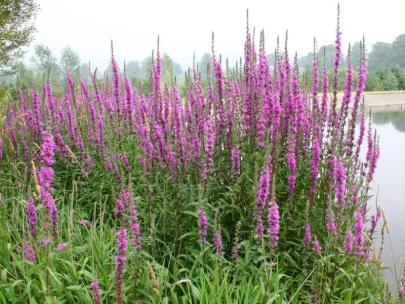New EPA Approvals
Purple loosestrife
In May 2024 the EPA approved an application from Horizons Regional Council to release four insects – two leaf beetles (Galerucella calmariensis and Galerucella pusilla), a stem-feeding weevil (Hylobius transversovittaus), and a flower-feeding weevil (Nanophyes marmoratus) – for the biocontrol of purple loosestrife in New Zealand.

Image: purple loosestrife
Introduced as an ornamental plant for its showy purple flowers, purple loosestrife has become a harmful invasive weed, particularly in Lake Horowhenua and surrounding areas in Manawatū on the west coast of the North Island. This tall, perennial plant outcompetes native plants in wetlands, reduces biodiversity, and can clog waterways. Current control methods such as manual removal and the use of herbicides are costly, have limited effectiveness, and can damage the delicate wetland environment.
The USA and Canada deployed these same four insect species in the early 1990s as part of their biocontrol programmes against purple loosestrife. The agents have proven to be effective there, with populations of the weed reduced by up to 90% at some sites within the first decade. This presented an opportunity for New Zealand to piggy-back on these well-established programmes using the host range testing data and evidence from the field to support a release application to the EPA for all four agents.
Horizons Regional Council, other National Biocontrol Collective members, and MWLR undertook pre-application consultation with Māori, which will continue, particularly in Horowhenua, as we start to prepare for the first releases planned for spring 2025.
Chilean needle grass
After more than 30 years of hard work and perseverance the journey of the Chilean needle grass rust (Uromyces pencanus) has come to an end – or rather can finally start! The rust fungus was approved for release in New Zealand, for a second time, in early July.
Image: Chilean needle grass.
The story began in the 1990s when the Cooperative Research Centres in Australia launched a project to research potential biocontrol agents for Chilean needle grass and nassella tussock (Nasella trichotoma). Our Argentinian collaborator, Freda Anderson (CONICET), was contracted to search for potential agents in the native range of Argentina. In 2001 New Zealand joined the project by providing additional funding for Freda’s work and had greater involvement as the project progressed.
The journey was far from smooth. We faced numerous challenges, including stubborn fungi that resisted cultivation for host range testing. By the time this testing was complete, and the EPA’s predecessor approved the release of the rust fungus in 2011, Argentinian export regulations prevented export of the rust to New Zealand.
Image: innoculating Chilean needle grass.
While we waited patiently, a revised phylogeny of the grass family (Poaceae) revealed that three New Zealand native grasses are more closely related to Chilean needle grass than had been initially determined. This meant additional host range testing was required, which could only be completed with an export permit from Argentina. After a decade-long wait we finally imported the rust into New Zealand and testing was completed by October 2023. Once a report was submitted to the EPA with the new host range results, a decision-making committee was convened, which approved the release of the rust without a public hearing.
Unfortunately, the strain of U. pencanus approved for release does not infect Hawke’s Bay populations of Chilean needle grass, so future work will need to focus on finding effective strains for the North Island populations. We are currently preparing for the first release in Marlborough this spring. We hope that all the hard work and determination will pay off and the rust will flourish, contributing to management of the Chilean needle grass rust in the South Island.
The purple loosestrife project is funded by Horizons Regional Council. The Chilean needle grass project is funded by the National Biocontrol Collective and the Ministry for Primary Industries’ Sustainable Food, Fibre and Futures Fund.
